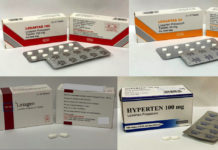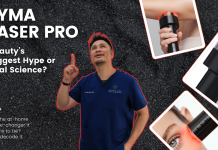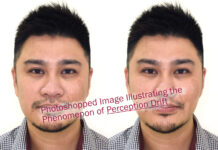Fillers – A Popular Treatment With a Bad Reputation
Dermal fillers, or soft-tissue fillers, are a popular, minimally invasive treatment where a substance (most commonly hyaluronic acid) is injected to plump up the skin. It has become very popular in recent years, as it is very effective, and safe in the right hands. Fillers can be used to treat many areas on the face, including the forehead, cheeks, temples, lips, and jawline(1). It can also be used to enhance facial features such the nose and chin.
Fillers have really changed the way we treat aging. Instead of having to undergo a facelift surgery, we can now take years off our patients’ faces in just an hour, with minimally invasive injections.
Unfortunately, soft tissue fillers have gotten quite a bad reputation of late. Very often when I tell my patients to consider some fillers, they will express concern – they will describe a friend who has done fillers, and looks puffy, or they will tell me about a celebrity they love who now looks unnatural and stiff after what they think are filler injections.
The situation is so bad, that recently, there were patients who even cancelled their filler injections appointments for fear of looking puffy and unnatural. Others who had it done also expressed concern about how the fillers will affect them in the long term. Hence, I decided to write this article (and make a video) to allay my patients’ concerns about their filler treatments.
Apple Cheeks Change and Sag With Age

You may have heard of apple cheeks”,or 苹果肌, an endearing term used to describe rounded cheeks in women which resemble apples, particularly when smiling. They are very sought after, especially in Asian cultures, as they signify youthfulness.
Anatomically, the apple cheeks are formed mainly by the deep fat compartments of the face, located beneath the muscles responsible for facial expressions. As we age, it is not only the skin which becomes less elastic. We now know that aging of the cheek area involves all facial structures – from the fat, muscles and even bone (2).
We lose volume in the cheeks as we age, making the apple cheeks look less full. The skin and superficial fat pads sag due to gravity, giving the appearance of folds, and wrinkles. Finally, with resorption of bone(3), there is less support for the complex structures which form the cheeks, worsening the sagging even further.
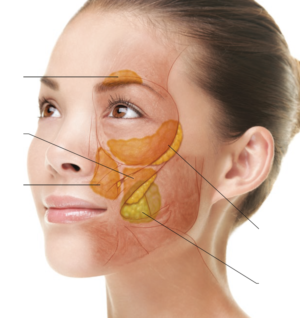
Fillers Restore Apple Cheeks. But Problems can Occur
One of the most common areas where filler injections are done are the cheeks and the undereye area.
When injected, fillers create volume in the cheeks – restoring the apple cheeks which time have taken away. By injecting in certain points, doctors can also use fillers to lift the skin around the cheeks.
If all these seem too good to be true, it unfortunately can be. The rampant and indiscriminate use of fillers have given rise to the huge problem in medical aesthetics we see today – the overfilled syndrome.
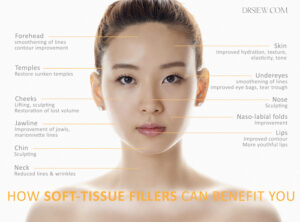
OverFilled Syndrome – A Big Problem Today
You do not have to look very far to understand what the overfilled syndrome is all about.
Everywhere you look, you can see famous faces who are unnaturally puffed up. The term “pillow face” is used to describe unnatural and puffy looking cheeks from filler injections. It is so widespread that you see it in celebrities, politicians’ wives, and both men and women, all over the world.

Why is this happening?
The problem is two-fold. One, doctors and injectors are putting in too much fillers. Two, doctors are re-injecting fillers too often. As I explained in a previous article, overfilled faces often do not happen overnight. They happen when patients undergo repeated filler injections. This unintentional overfilling can, in turn, be explained by 2 reasons.
1) Visual Adaptation and Perception Drift
The concepts of visual adaptation, and perception shift are important to understand here.
Believe it or not, our concept of what is beautiful changes, according to what we are exposed to. Because we are exposed to more and more exaggerated faces on platforms like Instagram, we begin to accept it as being normal or even beautiful. What we used to think of as being unnatural: thick, fish lips, exaggerated cheekbones, slowly become normalised in our subconsciousness as we see them over and over again. This is visual adaptation (4).

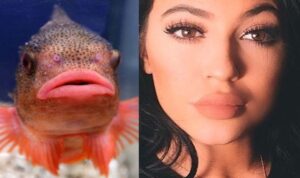
Perception Drift(5) is a phenomenon first described by Dr Sabrina Fabi. As we undergo repeated cosmetic procedures over time, we forget how we used to look like. Because of this, evaluation of what we want to achieve with cosmetic procedures shift as well. We end up wanting more and more, and our facial features change, without us realising it.
The two phenomena happen not only to patients but also to us doctors and injectors – Our patients come asking us for more, and we unwittingly give it to them, creating pillow-faced faces unintentionally.
I illustrate this phenomenon, using my photoshopped pictures as an example. A man may come asking for cheek and chin fillers, and an eye lift for a more V shaped face. 1 year later, he comes again, asking for the same procedure. Both he and his doctor do not realise the results are still there, and so the doctor repeats the treatment. After undergoing a couple more treatments, he may think he looks slightly enhanced, but it is only when you compare his before and after photos when it becomes evident that he has become an unnatural, puffed up caricature of himself.


2) Fillers Last Longer Than We Know
The second important thing we need to know is that fillers last much longer than we previously know. Traditionally, we are often told that fillers last six months to a year. This information is derived from what we know from filler approval studies. Restylane, for example, was shown in the USFDA study to reduce nasolabial fold severity for 6 months.
However, most of the studies do not follow up the patients until the results disappear. In reality, fillers last much longer than the 6-12 months cited in scientific papers. Their longevity depends on which part of the face is treated. It also varies between individuals. In this Youtube video, a radiologist shows on MRI scans that hyaluronic acid dermal fillers last for years in the face.
From personal experience, fillers often last for at 2 to 4 years, and even up to 10 years, yet, many people go for re-injections of fillers every year.
This frequent reinjection, combined with our errors in judgement with perception drift, are the reasons why overfilling has become more and more common.

A Vicious Cycle of Filling, Sagging, and Overfilling
When you look at celebrities’ pictures, you will notice that their cheeks become more and more plumped up over the years as they age. This is a tell-tale sign that re-injections of fillers were done before the original ones were metabolised.
When we Inject more and more product into a fixed space, the cheeks become heavier and start to sag downwards due to gravity (very much like how breasts sag faster after breast implant surgery). Next, as the cheeks sag, folds began to appear – such as the nasolabial folds, and the naso-jugal folds. In order to restore the smooth contours of the face, more fillers have to be injected, making the cheeks even heavier in a vicious cycle of filling, sagging and overfilling. We are also taught to inject into the cheek bones to give the face a more V-shaped visage.
Dcotors are also taught to inject into the cheekbones to accentuate them and to create a more V-shaped visage. This makes our cheeks look even bulkier than they already are.

Overfilled Cheeks Look More Obvious With Expressions
The cheeks are a very special area, because they undergo a lot of changes with facial expressions. In particular, the cheeks move upwards when we smile. This upward displacement is 12.43mm in men and 8.75mm in women (6). The anatomical basis of this change is the presence of a midfacial structure termed the transverse facial septum, which was only recently discovered! The septum is attached to muscles responsible for smiling, and the bone maxilla. When the zygomaticus major muscle contracts during smiling, the septum tense up like a hammock pushing the cheeks upwards and forwards to reveal apple cheeks.

Soft Tissue filler injections are mostly done when the patient’s face is at rest. The problem is, when the doctor puts in enough filler to make the cheeks look full at rest, too much is already put in. when the patient smiles, the fillers get pushed upwards and outwards, making the puffiness look even worse. You can also see this happening in the picture below in Madonna. At rest, she looks good, but when she smiles, the puffy cheeks become evident. Hence, I always take great care to make sure that the patient looks natural, both at rest, and with facial expressions, when performing filler injections.

How Do We Avoid Looking Puffy with Fillers?
Despite all the bad publicity and horror stories, soft tissue fillers are an essential tool for anti-aging. The key is not to overdo it. As perception drift affects both patients and doctors, it is very important to carefully examine our patients, and look through their old photos when they return for follow-up fillers.
By meticulously examining my patients each time they come for a repeat filler treatment, comparing their photos from the first treatment with me to the present day, I am very sure I am restoring them to their youthful self, and not turning them into a pillow-faced monster. The truth is, more often than not, after examination, I end up telling my patients that they do not need any filler treatment at the moment, and I ask them to return a year later for re-evaluation.
Less is more. I personally do not inject 10 syringe of fillers at once for everyone. Some patients indeed need more than others, but it should always a customised approach, after examining their anatomy, needs, and goals.
In my opinion, it is important to look age-appropriate. With modern science, we can now age gracefully. However, problems arise when we try to overdo it, and chase down every line and wrinkle. Remember that in the normal aging process, we should be looking less plump with age, not the other way round. If, with injectable treatments, our cheeks end up looking more and more puffy as we age , it becomes a tell-tale sign that work has been done to the face.
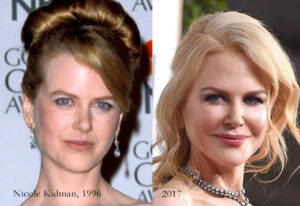
What Should You Do To Remedy the Situation If You Look Puffy After Fillers?
Fortunately, most fillers are made of Hyaluronic Acid (HA), which are not permanent and get metabolised after some time. HA fillers can also can be dissolved immediately with an antidote known as Hyaluronidase. My advice to people who are overfilled is not do any more fillers until the previous ones have metabolised. You can also consider dissolving the current fillers in your face, and start over, this time, making sure that you and your doctor goes slow, and examines your old photos before treating you. I have taken this approach, with great success, with many overfilled patients, some of whom are public personalities as well.
Some of the patients I had to dissolve the fillers for were injected by myself in the past. I myself am not spared from making the mistake of overfilling my patients. When I do spot a mistake I made previously, I will point it out to my patient that I have overfilled them, and offer to dissolve the fillers for them. As a doctor, I believe It is important to be objective, spot the problem when there is one, admit our mistake and right the wrong we have done to our patients.
Courtney Cox famously had her fillers dissolved in 2017, as she felt she did not look like herself anymore. Indeed, she does look more natural without fillers, especially when she is smiling.


Combination Treatments is Key For A Natural Result.
Combination treatments are almost always necessary for best anti-aging results. Soft-tissue fillers are just one of many tools against aging. When we attempt to use only one tool to do everything from plumping to lifting, we run into problems. For example, lifting of the skin, and especially repositioning of the cheek fat to its original, youthful position, is also equally important. This can be done with energy based devices such as Ultherapy. For more severe cases of skin sagging, a surgical facelift gives a more long-term, definitive solution.
It is always better to work on the face progressively and slowly, much like how we add brushstrokes to a painting. Michaelangelo took nine years to paint Sistine Chapel ceiling – I always tell my patients but there is no rush to do too much at once. By taking it slowly, we can avoid problems such as overfilling, and make sure you look refreshed and natural with every treatment.
References:
- Mendelson B, Wong CH. Changes in the facial skeleton with aging: implications and clinical applications in facial rejuvenation. Aesthetic Plast Surg. 2012 Aug;36(4):753-60. doi: 10.1007/s00266-012-9904-3. Epub 2012 May 12. PMID: 22580543; PMCID: PMC3404279.
- Lipko-Godlewska S, Bolanča Ž, Kalinová L, et al. Whole-Face Approach with Hyaluronic Acid Fillers. Clin Cosmet Investig Dermatol. 2021;14:169-178. Published 2021 Feb 17. doi:10.2147/CCID.S292501
- Mendelson BC, Muzaffar AR, Adams WP. Surgical anatomy of the midcheek and malar mounds. Plast Reconstr Surg 2002;110:885–96;discussion 897–911.
- Webster MA, MacLeod DI. Visual adaptation and face perception. Philos Trans R Soc Lond B Biol Sci. 2011;366(1571):1702-1725. doi:10.1098/rstb.2010.0360
- Sola CA, Fabi SG. Perception Drift. Dermatol Surg. 2019 Dec;45(12):1747-1748. doi: 10.1097/DSS.0000000000001823. PMID: 30985338.
- Cotofana S, Gotkin RH, Frank K, Lachman N, Schenck TL. Anatomy Behind the Facial Overfilled Syndrome: The Transverse Facial Septum. Dermatol Surg. 2020 Aug;46(8):e16-e22. doi: 10.1097/DSS.0000000000002236. PMID: 31688233.





